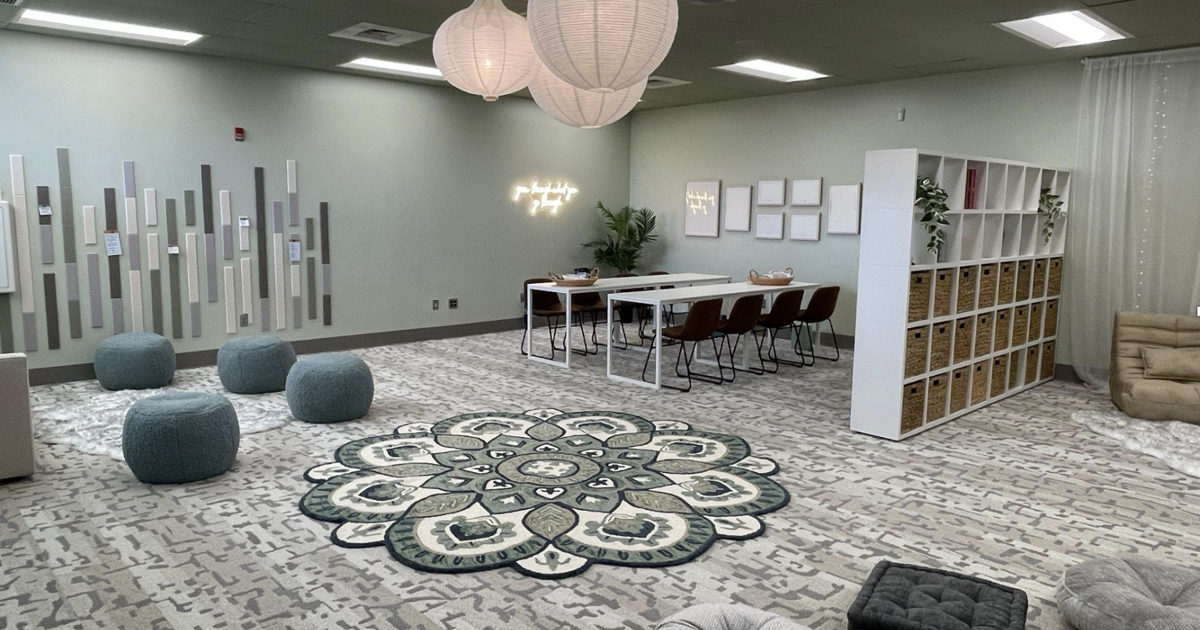Creating an on-campus room that doesn’t feel like it belongs in a school may seem counterproductive –– but that’s exactly what school leaders hope to accomplish.
The new spaces, known as wellness rooms, are popping up across Tampa Bay high schools in an effort to improve mental health care access among teenagers. Behind the movement is Tampa Bay Thrives, a coalition founded in 2019 to address mental health challenges in the region.
The nonprofit has partnered with four schools so far –– Sligh Middle School, Brandon High School, King High School and Pinellas High Innovation –– to provide funding for the creation of these spaces.
“Schools are designed for a purpose, so they have a tendency to look very institutional in a lot of ways,” said King High School Principal Gregory Basham. “And a wellness room is exactly the opposite of that.”
At King High, the wellness room feels like a mix between “an upscale hotel” and a Starbucks, Basham said. It’s been dubbed “The Oasis” and features spaces where students can unwind or collaborate with other students.
“Everybody deserves a space that’s as nice as possible, that they can go and have a moment to themselves,” he said.
That reasoning resonates with Tampa Bay Thrives CEO Carrie Zeisse.
The rooms are meant to be preventive, meaning they provide support before resorting to more formal types of care, such as therapy. The outcomes have ranged from increased student attendance to decreased behavioral referrals, she said.
“It’s like a deep breath. It’s just the kind of space that invites you to relax and invites you to take care of yourself,” Zeisse said about the rooms.
Tampa Bay Thrives’ first wellness room opened at Sligh Middle School in December 2023. The spaces at King High and Brandon High are opening to the student body this month, and the room at Pinellas High Innovation will be unveiled later this year.
Brandon High School Principal Allison Wright said the initiative is most impactful for high school students due to the outside pressures they face in day-to-day lives — from college applications to social media.
It also allows students to learn coping mechanisms before leaving high school and going out “into the real world as adults,” Wright said.
“The sooner we can help them learn it in high school, the better they can perform and achieve. Then, the better adults they’ll be,” she said.
She believes the wellness rooms are just as important as the school’s other resources for its student body, such as its food and clothing pantry. Some of the activities students might do in the wellness room, which is called the “Eagle’s Nest” at Brandon High, are yoga, painting or other mindfulness strategies.
Part of the challenge with the rooms is striking a balance for student access. While school leadership wants students to access the room when they’re in need, Basham said it’s important to prevent the loss of instructional time.
To address this, he said students will be able to access the rooms before and after school, as well as during lunch time. Teachers will also be able to schedule times to bring their class into the room if they want to.
While all rooms were done in partnership with Tampa Bay Thrives, their layout varies. Students were picked at all schools to sit down with designers to give them autonomy over the project.
“They know more about what they need than we do,” Zeisse said. “We want to make sure that as we stretch our dollars to do the most that they possibly can, that we are doing it with the perspective of the young people whose lives we want to help influence.”
Students’ involvement doesn’t end there either. The nonprofit helped train mental health ambassadors at the schools through a three-day program over the summer.
The ambassadors will wear their own branded shirts and lanyards so they’re easily recognizable by other students in case they need support. In addition, Tampa Bay Thrives will pay for one full-time staff member at each school to serve as program manager for the rooms.
Zeisse’s goal is to eventually create a cohort of 10 schools; however, that will be dependent on funding. She said each room costs between $30,000 to $50,000 to furnish, plus $75,000 to $100,000 on operational costs, program supplies, and the staff member’s salary.
Wright, the Brandon High principal, said she’s already getting questions from students about the room and when they’ll be able to access it.
Even she can’t deny its appeal.
“There’s times that I would need to get work done and I would go sit in there, because it’s comfy. It’s cozy. I feel relaxed in here,” she said.

